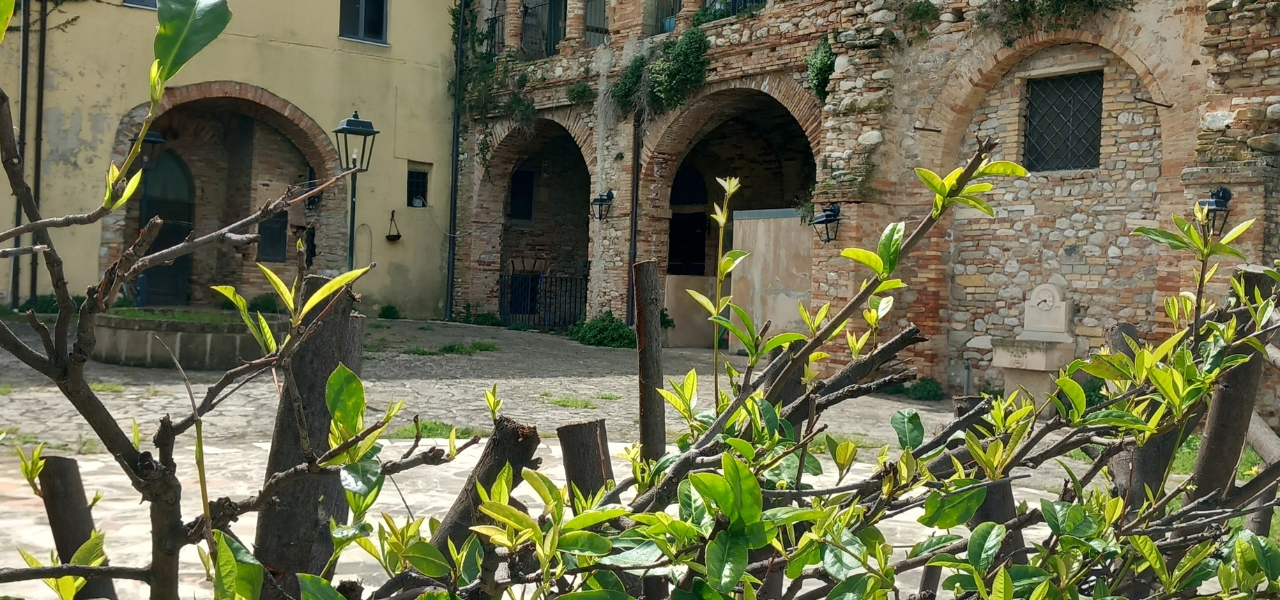The oldest stable settlement of human groups in the territory of Catignano dates back to the Neolithic period. From the 1960s-1970s onwards, a series of surveys and archaeological excavations conducted in the locality of Ponte Rosso at Km 39 of the SS. 602 brought to light a rich collection of artifacts dating back to the 6th – 5th millennium BCE.
In this location, near a lush watercourse, groups of people organized a village of which fascinating traces remain, now visible at the archaeological site. Cavities of various shapes were identified on the surface of the site, testifying to the activities and life organization of these prehistoric groups: huts, combustion pits, pits (silos], and burials.
In the archaeological area, numerous artifacts have also been found, providing evidence of the daily habits, early cultural forms, and artistic craftsmanship developed by these prehistoric human settlements. These mainly include pottery vessels with impressed or painted decorative elements, household items, and some small clay idols in anthropomorphic forms. In the protohistoric period and until the early centuries AD, these communities moved, occupying other areas adjacent to the current inhabited center. Catignano likely emerged on the ruins of the ancient Cutina.
According to what Tito Livio reported in his books dedicated to the History of Rome, Cutina would have been one of the strongest and most tenacious centers of the Vestini people. Together with Cingilia, it was among the centers that resisted the Roman army's occupation for the longest time. For this reason, around the 4th century BCE, it was completely destroyed, and its traces were definitively lost. During the Middle Ages, the toponym transformed into Catenianum and Catigitanum, two terms referring to the word "chain." This reference could have various explanations, including the most suggestive and evocative one of a place destined for deportation and imprisonment, or that the word would derive from catonius + anus, referring to a land tax, calculated for centuries using the chain as an ancient measure of length and surface, especially agricultural.
During the Middle Ages and especially in modern times, the town always played a certain political and social role.
Of the medieval castrum, only a few traces remain in the scarped walls and the typical circular housing distribution of the fortified village, now identified as Via del Castello. According to the Chronicle of the monastery of S. Bartolomeo, in 964, Rodelando di Penne donated land near Catuniano, where a small church dedicated to S. Agnea (?) stood, to the Carpineto monastery; it is possible that it was an ancient church, perhaps dedicated to S. Agnese or S. Anna, which may have undergone linguistic alterations in written and oral transmissions. Probably the document refers to the current church of S. Irene, formerly the Nativity of the Virgin, located in Contrada Cappuccini. The building, as we see it today, was built by the Benedictines between the 11th and 12th centuries and is a splendid example of Abruzzo Romanesque art.
With the arrival of the Swabians in Abruzzo in the 13th century, the ancient village experienced a moment of crisis. After a Ghibelline revolt, Mario Bruxerio, lord of the Catignano castle, was imprisoned, and King Charles of Anjou ordered the confiscation of his property. From this moment, the castle and its properties were fragmented and divided among various lords of Loreto. In the 15th century, Alfonso of Aragon granted Catignano and all its possessions to Count Battista Camponesco of L'Aquila. In 1469, the village was purchased, along with others nearby, by Michele D’Afflitto, son of Luigi, royal adviser to Ferdinand I of Aragon.
During the French invasion between the late 18th and early 19th centuries, Catignano became a destination and refuge for brigands, many of whom were killed by the French during the invasion of the city of Pianella in 1806. Unfortunately, few records exist from this period because during the first half of the 19th century, a significant part of the municipal archive was destroyed in a violent fire.
Before Law No. 30 of August 2, 1806, through which the French government initiated the definitive abolition of feudalism, the Municipality of Catignano was a baronial land under the control of Duke Michele Bassi of Alanno. In 1807, the latter, a noble pro-French in the service of the Napoleonic government, was elected Intendant in Capua. In those years, due to its congenial geographical position, Catignano became the capital of the district of the then province of Teramo. There, from 1811 to 1817, the Judicature of Peace had its seat, replacing Governors and Baiuli in local jurisdiction.
Reference Biography:
- "Centri storici della Val Pescara dall’Evo Medio ai nostri giorni," edited by G. Chiarizia, Pescara 1990.
- "Terra Vestina. L’area vestina della Provincia di Pescara," Pescara 1992.
- R. Mancini, "Viaggiare negli Abruzzi," L’Aquila 2006.
- "Dalla Valle dell’Orta alla Valle del basso Pescara," in "Documenti del’Abruzzo Teramano," edited by L. Franchi Dell’Orto, vol. VI, Teramo





